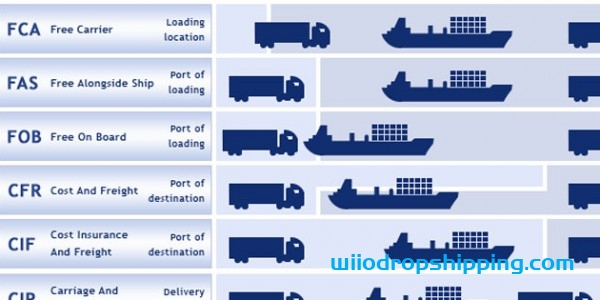Physical Address
304 North Cardinal St.
Dorchester Center, MA 02124


Although other clauses for global trade exist around the world, such as the Harmonised Tariff Schedule of the United States, Incoterms® rules are global in their reach. Similarly, Incoterms® rules do not include trade terms codified for national purposes, such as the “less than truckload shipping” (LTL) rule of the United States. Unlike national trade policies, Incoterms® rules are universal, providing clarity and predictability to business.
“Incoterms®” is an acronym standing for international commercial terms. “Incoterms®” is a trademark of the International Chamber of Commerce, registered in several countries.
The Incoterms® rules feature abbreviations for terms, like FOB (“Free on Board”), DAP (“Delivered at Place”) EXW (“Ex Works”), CIP (“Carriage and Insurance Paid To”), which all have very precise meanings for the sale of goods around the world.
These terms hold universal meaning for buyers and sellers around the world. If you are a financial analyst in the City of London, then you might associate the acronym “FCA” with the United Kingdom’s Financial Conduct Authority. However, for importers and exporters around the world, FCA is the initials used for “Free Carrier,” or the seller’s obligation to deliver the goods to the carrier nominated by the buyer at the seller’s premises or another named place.
The seller makes the goods available at his/her premises. The buyer is responsible for uploading. This term places the maximum obligation on the buyer and minimum obligations on the seller. The Ex Works term is often used when making an initial quotation for the sale of goods without any costs included. EXW means that a seller has the goods ready for collection at his premises (works, factory, warehouse, plant) on the date agreed upon. The buyer pays all transportation costs and also bears the risks for bringing the goods to their final destination. The seller does not load the goods on collecting vehicles and doesn’t clear them for export. If the seller does load the goods, he does so at buyer’s risk and cost. If parties wish seller to be responsible for the loading of the goods on departure and to bear the risk and all costs of such loading, this must be made clear by adding explicit wording to this effect in the contract of sale.
The seller delivers goods, cleared for export, to the buyer-designated carrier at a named and defined location. This is used for any mode of transport. The seller must load goods onto the buyer’s carrier. The key document signifying transfer of responsibility is receipt by carrier to exporter.
The seller pays for carriage. Risk transfers to buyer upon handling goods over to the first carrier at place of shipment in the country of export.
This term is used for all kind of shipments.
The containerized transport/multimodal equivalent of CIF. Seller pays for carriage and insurance to the named destination point, but risk passes when the goods are handed over to the first carrier.
Seller pays for carriage to the terminal, except for costs related to import clearance, and assumes all risks up to the point that the goods are unloaded at the terminal.
Seller pays for carriage to the named place, except for costs related to import clearance, and assumes all risks prior to the point that the goods are ready for unloading by the buyer.
Seller is responsible for delivering the goods to the named place in the country of the buyer, and pays all costs in bringing the goods to the destination including import duties and taxes. The seller is not responsible for unloading. This term is often used in place of the non-Incoterm “Free In Store (FIS)”. This term places the maximum obligations on the seller and minimum obligations on the buyer.
Sea and inland waterway transport
To determine if a location qualifies for these four rules, please refer to ‘United Nations Code for Trade and Transport Locations (UN/LOCODE)’. [Link below]
The four rules defined by Incoterms 2010 for international trade where transportation is entirely conducted by water are:
The seller must place the goods alongside the ship at the named port. The seller must clear the goods for export. Suitable only for maritime transport but NOT for multimodal sea transport in containers (seeIncoterms 2010, ICC publication 715). This term is typically used for heavy-lift or bulk cargo.
The seller must load the goods on board a vessel designated by the buyer. Cost and risk are divided when the goods are actually on board of the vessel. The seller must clear the goods for export. The term is applicable for maritime and inland waterway transport only but NOT for multimodal sea transport in containers (see Incoterms 2010, ICC publication 715). The buyer must instruct the seller the details of the vessel and the port where the goods are to be loaded, and there is no reference to, or provision for, the use of a carrier or forwarder. This term has been greatly misused over the last three decades ever sinceIncoterms 1980 explained that FCA should be used for container shipments.
It means the seller pays for transportation of goods to the port of shipment, loading cost. The buyer pays cost of marine freight transportation, insurance, uploading and transportation cost from the arrival port to destination. The passing of risk occurs when the goods pass the ship’s rail at port of shipments.
Seller must pay the costs and freight to bring the goods to the port of destination. However, risk is transferred to the buyer once the goods are loaded on the vessel. Insurance for the goods is NOT included. This term is formerly known as CNF (C&F, or C+F). Maritime transport only.
Exactly the same as CFR except that the seller must in addition procure and pay for the insurance. Maritime transport only.